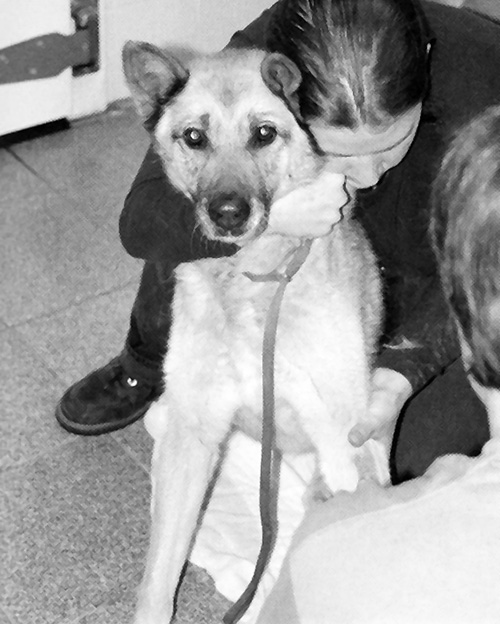General, Sheltering, Pet Overpopulation
How much is a life worth?

Mutt Lover
December 14, 2016
Reading Time: About 2 minutes

emember how I warned you in my first blog post that there might be times when I would make you cry? Well, this is probably one of those times. Early in my rescue work, I came across a book that had a profound effect on my views and perspectives on the issue of pet overpopulation, sheltering and how some of us humans choose to deal – or not – with our companion animals.
This is a book that I have been talking about and “pushing” on anyone who shows even a remote interest in this topic. One at Time: A Week in an American Animal Shelter by Diane Leigh and Marilee Geyer (see our book recommendations for more details) is a powerful book, one you are not likely to forget quickly. The writing is wonderful and insightful; the photographs are unforgettable.
The authors – both former shelter workers – selected 75 animals, at random, that came through the doors of an animal shelter in California in the course of one week. They recorded their experience from intake to disposition, whatever that turned out to be. In some cases, the stories had happy endings; the animals were either reclaimed by their guardians or were adopted by new families. But that was not the case for all of them. In fact, that wasn’t even all of them. The actual number of animals coming into that shelter in that one week was 363 with 117 of them being euthanized.
Every one of those 75 stories is memorable but there is one in particular that has stuck with me since the day I read it well over a decade ago.
Her story is posted below with the permission of one of the authors: Diane Leigh.
Kelly, #A066769
From One at a Time: A week in an American Animal Shelter, by Diane Leigh and Marilee Geyer
How much is a life worth?
Kelly was a beautiful golden Husky mix with black sable points and thick, luxuriant fur. She was older, probably at least eight; her eyesight was diminished and she was beginning to show hip problems.
The animal control officer arriving at work at 6 a.m. discovered her in the shelter’s play yard. Probably someone had found her on their way to work, brought her to the shelter and finding it not yet open, left her in the yard.
Her guardian was contacted using the information on the tag she was wearing and came to get her a few hours later. She seemed relieved to know Kelly was safe, but upon learning that she would be required to pay a standard twenty dollar reclaim fee, she balked. “Why would I pay when she’ll only get out again?” asked the woman. Apparently Kelly had been lost before.
After arguing with the staff over the fee, she decided she was unwilling to pay it, and instead began the paperwork that would sign Kelly over to the shelter. “She’ll get adopted, won’t she? She is a great dog!” she said. The staff made it clear that there were no guarantees and that not all animals surrendered to the shelter got new homes.
Still, the woman continued with the paperwork, even filling out a personality profile documenting Kelly’s life and history: she had been “adopted from a family” by this woman two years ago and had at one point been trained to assist a visually impaired person. In her current home, though, she was primarily a “yard dog,” sleeping in a doghouse and being fed outside in the mornings. The woman wrote that Kelly was “extremely loving and lovable, very well behaved, gets along with children, elderly and other pets; will walk well with you on a leash as well as take you for daily runs; a good companion.”
Nonetheless, she completed the paperwork and walked out, keeping her twenty dollars in exchange for Kelly.
The staff was dumbfounded. If Kelly was such a “great, loving” dog, why would her guardian give her up over twenty dollars? Had she been looking for an excuse to get rid of the dog? Did she actually want to find her a new home? Knowing Kelly might not be adopted, how could the woman leave her there? There was simply no rational explanation, and sadly, it wasn’t the first time, nor would it be the last, the shelter staff witnessed such inexplicable behavior.
Back in the kennels, Kelly was devastated. Her grief was unmistakable. She did not eat, would not look up at anyone who stood in front of her kennel, did not lift her head as her photo was taken. She was so unresponsive, staff even wondered if she might be deaf. After three days, it was clear she was not going to bounce back from the trauma of being abandoned; puppies, even street dogs, do better in the shelter, having never known a home. It is the ones who had a home – the ones who have lost the most – who suffer the worst. And Kelly suffered immensely.

Her very suffering sealed her fate, virtually guaranteeing that she would not be adopted. And older dog, deeply depressed, would need the rarest, most sensitive of adopters to notice her, to consider taking her on.
These are the cases that make shelter workers turn hopeless, depressed, angry, bitter. These are the cases that make them feel that their shelter is not, as they wish, sanctuary and safety for the animals, but instead an institution that makes easy the disposal of living beings. These are the cases that make them feel that their job is cleaning up after a society that doesn’t care.
They were angry and sad at Kelly’s situation. But they put it aside, choked it back, and focused on giving Kelly tenderness and dignity as they eased her from this world, as the priceless life that was Kelly slipped away.

Kelly. Photograph Courtesy of Diane Leigh and Marilee Geyer.
Comments are moderated and will not display until they are approved.




0 Comments